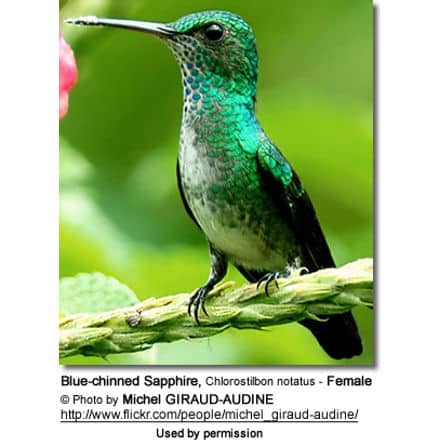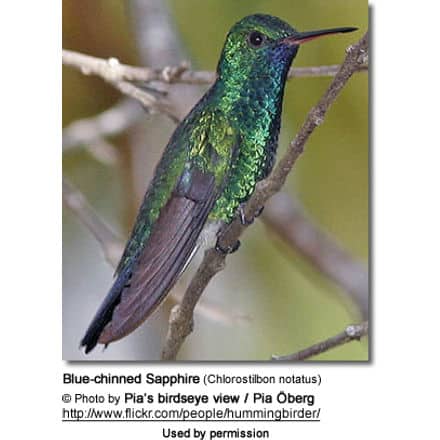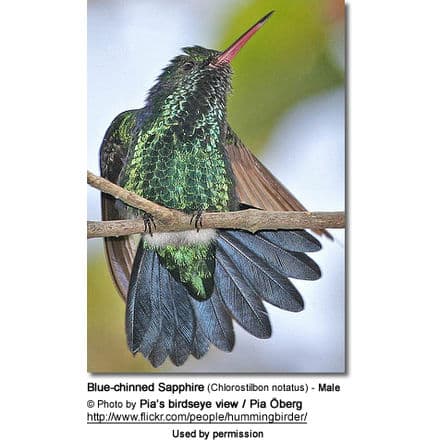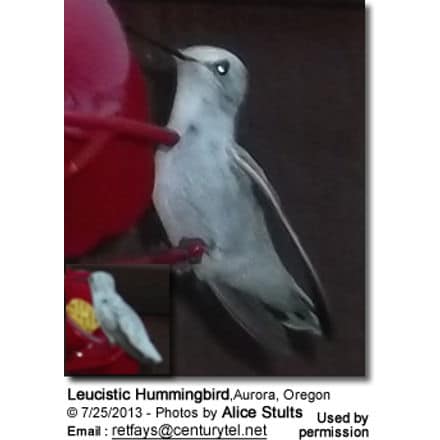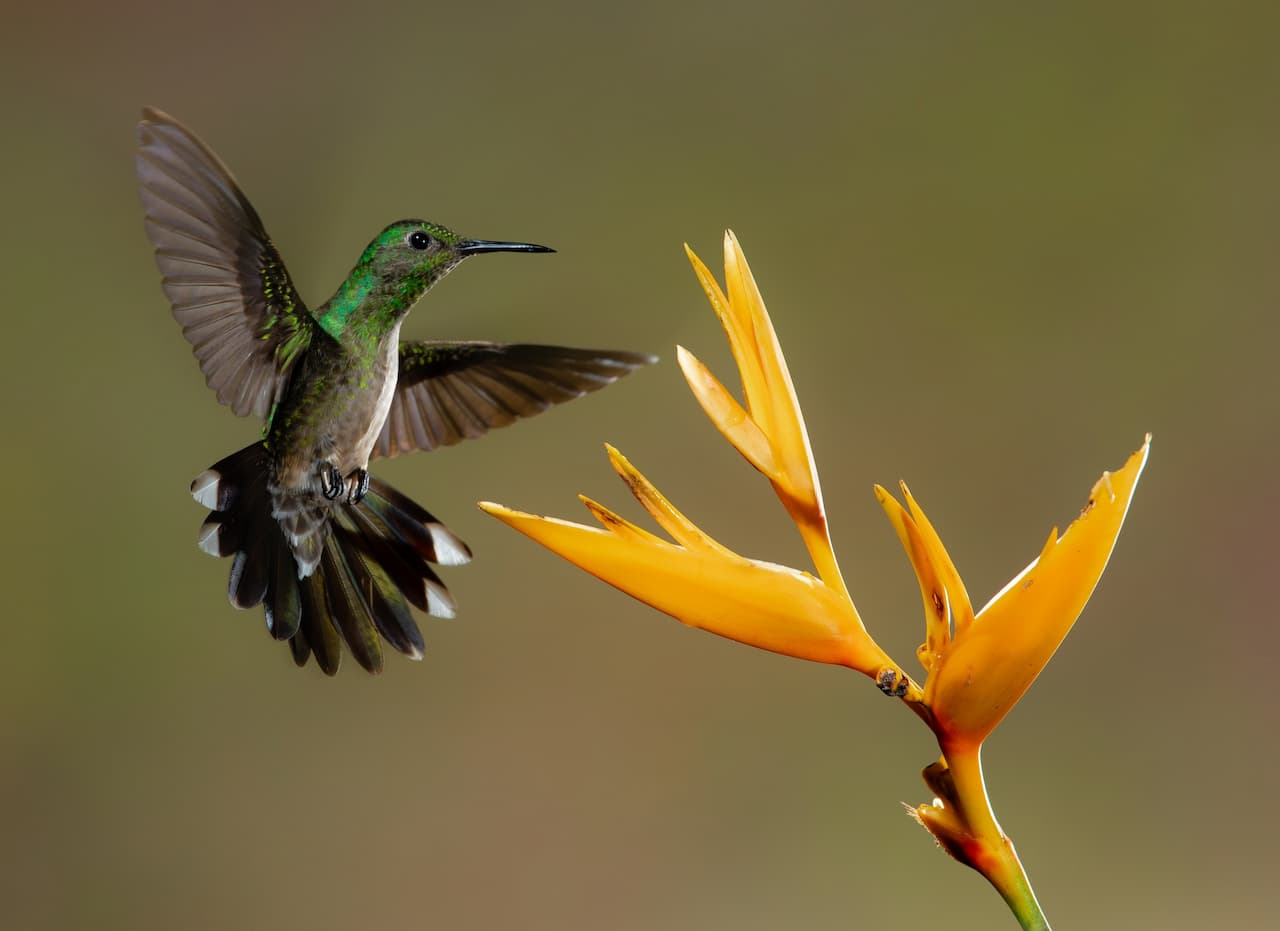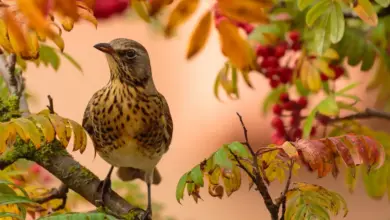Blue-chinned Sapphire Hummingbirds
The Blue-chinned Sapphire (Chlorostilbon notatus) – also known as Black-chinned Sapphire – is a South American hummingbird that is found in Colombia ranging south to the Guianas, Trinidad and Brazil, and Peru. The nominate race is also found on the island of Tobago.
They are quite common on the island of Trinidad but are a rare species on the adjoining island of Tobago.
In Brazil, it occurs along the main Amazon River Basin, as well as the coastal Atlantic Ocean.
They prefer forest habitats and sometimes are seen along the forest edge and cultivated areas with large trees. However, for the most part, they appear to be avoiding residential areas.
Alternate (Global) Names
Spanish: Colibrí Verdecito, Esmeralda Gorgiazul, Zafiro Gorgiazul; Portuguese: Beija-flor-de-garganta-azul, Safira-de-garganta-azul; French: Colibri à menton bleu, Émeraude à menton bleu;
Italian: Colibrì zaffiro golablu, Zaffiro mentoblu; Czech: Kolibrík modrobradý, kolib?ík modrobradý; Danish: Safirkolibri; German: Blaukinnelfe, Blaukinn-Elfe, Blaukinnkolibri, Blaukinn-Smaragdkolibri; Finnish: Sinileukakolibri; Japanese: aiohachidori; Dutch: Blauwkeelsaffierkolibrie, Blauwkeel-saffierkolibrie; Norwegian: Blåstrupesmaragd; Polish: zlocik szafirowy, z?ocik szafirowy; Slovak: Smaragdovec modrobradý; Swedish: Safirkolibri
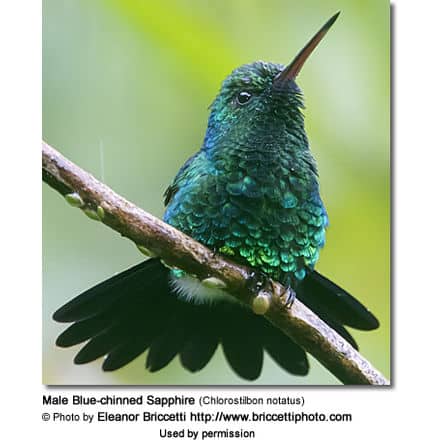
Subspecies and Ranges
- Chlorostilbon notatus notatus (Reich, 1793) – Nominate Race
- Range: Northeastern Colombia through north and eastern Venezuela, Trinidad and Tobago, and the Guianas to eastern Brazil (Pará to Bahia).
- Chlorostilbon notatus puruensis Riley, 1913
- Range: Northwest Brazil (north of Amazon, east to mouths of Trombetas and Negro rivers) to southeastern Colombia and northeast Peru (upper Ucayali river).
- Range: Northeastern Peru on the lower Ucayali River near mouth of river Napo, and west, probably to mouth of river Huallaga.
Description:
The Blue-chinned Sapphire is 3.5 inches or 8.9 cm long and weighs 0.13 oz or 3.8 g.
The bill is fairly straight. The upper beak is black and the lower is reddish.
The male has a vivid green back and rump (lower back). Below also green, but lighter than the upper plumage. He has a blue upper throat / chin, white thighs, and a forked metallic blue tail. The blue chin is only visible when viewing the bird from the front.
The female‘s under plumage is white with green spots.
Hummingbird Resources
- Hummingbird Information
- Hummingbird Amazing Facts
- Attracting Hummingbirds to Your Garden
- Hummingbird Species
- Feeding Hummingbirds
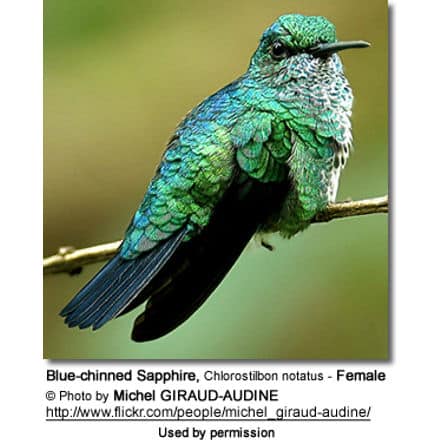
Nesting / Breeding
Hummingbirds are solitary in all aspects of life other than breeding, and the male’s only involvement in the reproductive process is the actual mating with the female. They neither live nor migrate in flocks, and there is no pair bond for this species. Males court females by flying in a U-shaped pattern in front of them. He will separate from the female immediately after copulation. One male may mate with several females. In all likelihood, the female will also mate with several males. The males do not participate in choosing the nest location, building the nest, or raising the chicks.
The female Blue-chinned Sapphire is responsible for building the deep cup-shaped nest out of plant fibers woven together and green moss on the outside for camouflage in a protected location in a shrub, bush, or tree. She lines the nest with soft plant fibers, animal hair, and feathers down, and strengthens the structure with spider webbing and other sticky material, giving it an elastic quality to allow it to stretch to double its size as the chicks grow and need more room. The nest is typically found on a low, thin horizontal branch.
The average clutch consists of two white eggs, which she incubates alone for about 16 days, while the male defends his territory and the flowers he feeds on. The young are born blind, immobile, and without any down.
The female alone protects and feeds the chicks with regurgitated food (mostly partially digested insects since nectar is an insufficient source of protein for the growing chicks). The female pushes the food down the chicks’ throats with her long bill directly into their stomachs.
As is the case with other hummingbird species, the chicks are brooded only the first week or two and are left alone even on cooler nights after about 12 days – probably due to the small nest size. The chicks leave the nest when they are about 18 – 19 days old.
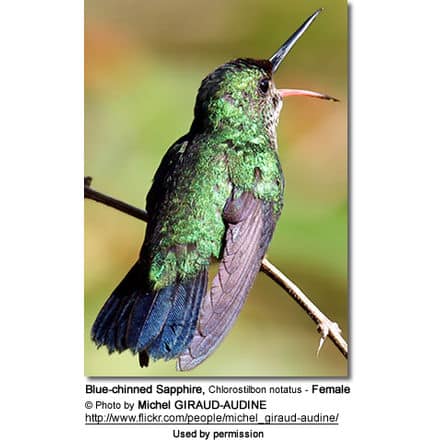
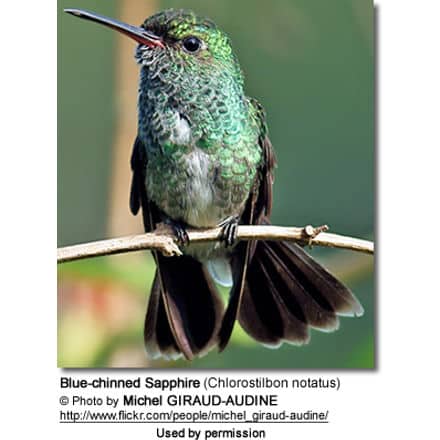
Diet / Feeding
The Blue-chinned Sapphires primarily feed on nectar taken from a variety of brightly colored, scented small flowers of trees, herbs, shrubs, and epiphytes. They favor flowers with the highest sugar content (often red-colored and tubular-shaped) and seek out, and aggressively protect, those areas containing flowers with high-energy nectar. They use their long, extendible, straw-like tongues to retrieve the nectar while hovering with their tails cocked upward as they are licking at the nectar up to 13 times per second. Sometimes they may be seen hanging on the flower while feeding.
Many native and cultivated plants on whose flowers these birds feed heavily rely on them for pollination. The mostly tubular-shaped flowers exclude most bees and butterflies from feeding on them and, subsequently, from pollinating the plants.
They may also visit local hummingbird feeders for some sugar water, or drink out of bird baths or water fountains where they will either hover and sip water as it runs over the edge; or they will perch on the edge and drink – like all the other birds; however, they only remain still for a short moment.
They also take some small spiders and insects – important sources of protein particularly needed during the breeding season to ensure the proper development of their young. Insects are often caught in flight (hawking); snatched off leaves or branches, or taken from spider webs. A nesting female can capture up to 2,000 insects a day.
Males establish feeding territories, where they aggressively chase away other males as well as large insects – such as bumblebees and hawk moths – that want to feed in their territory. They use aerial flights and intimidating displays to defend their territories.
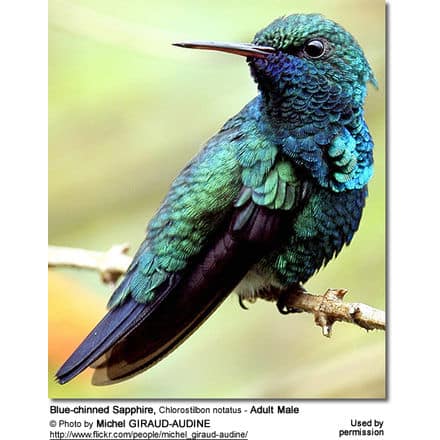
Song / Vocalization:
The Blue-chinned Sapphire song is described as a high metallic ssooo-ssooo-ssooo.


